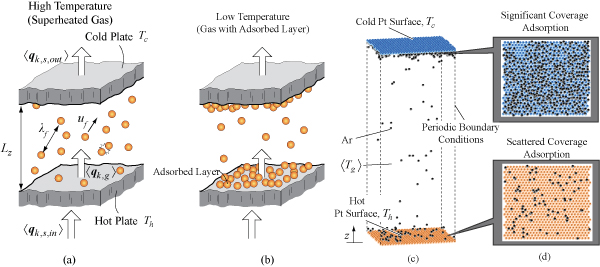Nanoscale Thermal Energy Transport
In nanoscale, thermal energy is represented by the atomic/molecular translational, vibrational, rotational motions, and their transport occurs through the interactions with adjacent atom/molecules. In fluid-solid systems, one of the dominant transport limits is a large interfacial resistance due to mismatched energy transfer modes. My study examines origin of the transport resistance near the interface, and discusses an optimal nanostructure to minimize it. Presence of a solid surface attracts the fluid particles by the intermolecular interactions, and condensable gas forms surface-adsorbed layers. This layer thickens with an increasing free energy of each fluid particle, and thicker adsorption decreases the interfacial resistance by reducing energy transport barriers. This suggests that the adsorption-assisted nanostructure enhances energy transport. Also, it is found that the adsorption kinetics along with the surface diffusion motion can be further explored for the nano heat pipe design and/or temperature-controlled thermal switch using intermolecular surface force/structural optimizations.

Links To Movie Files
Water_Transport_within_Graphene_Nanogap.mp4
Relavant Publications
- Gi Suk Hwang, and M. Kaviany, “Molecular Dynamics Simulation of Effective Thermal Conductivity of Vapor-Filled Nanogap and Nanocavity”, J. Appl. Phys., 106, 024317-1-6, 2009.

